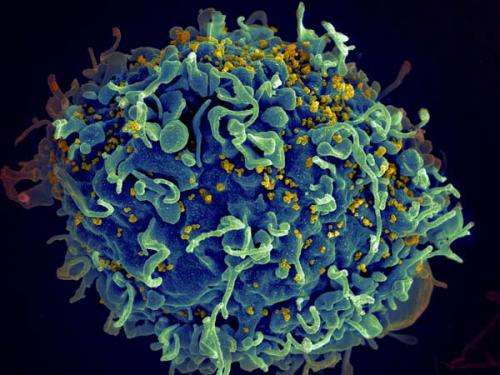Changes in HIV genetic code determine severity of disease

In a finding that furthers the understanding of human immunodeficiency virus (HIV), researchers from Children's Hospital Los Angeles discovered two locations where a single difference in HIV's genetic code altered the way the virus infected the cell, thereby influencing the progression of the disease.
The results of this study will be published in PLOS ONE on June 17.
HIV targets specific white blood cells, called CD4+ T-cells, which play an important role in organizing the immune response to bacteria and viruses. By using two different receptors, CCR5 (R5) or CXCR4 (X4), HIV is able to enter the host cells and gradually infect the immune system. Virtually all HIV infections use the R5 receptor to enter the CD4+ cell, but in approximately 50 percent of patients, the virus will switch and begin to use the X4 receptor. This switch is usually associated with worsening disease in the patient and renders the antiretroviral drugs targeted at the R5 receptor ineffective.
'In this study, we have uncovered new ways this wily virus can escape the control of anti-HIV treatments,' said Grace Aldrovandi, M.D., CM, chief of the Division of Infectious Diseases at Children's Hospital Los Angeles and the study's principal investigator.
Acting as a gatekeeper, a viral envelope mediates the entry of HIV into the host cell. The envelope itself consists of a portion of the host cell membrane and molecules called glycoproteins, specifically gp120 and gp41, which are generated by HIV's genetic code. The three units of gp120 rest on the cell's surface. Each gp120 molecule is further divided into five constant regions, labelled C1 through C5, five variable regions, labelled V1 through V5, and a connecting structure called a bridging sheet.
Previous studies have found that signaling from the V3 region of gp120 is primarily responsible for determining which receptor—R5 or X4—HIV uses to infect the CD4+ cell. To pinpoint the mechanisms for the receptor 'switch', researchers in this study isolated closely-related viral envelopes that had identical V3 sequences, but signaled different receptors. Further testing revealed that the use of the X4 receptor is not only controlled by the V3 region, but that it is also influenced by slight genetic changes to the C2 region and to the bridging sheet of the gp120 molecule. This is the first time these two areas have been linked to HIV's receptor usage.
'It is our hope that discovery of additional mechanisms for HIV's switch from the R5 to the X4 receptor may allow scientists and clinicians to better predict, and potentially counter, the ability of HIV to escape antiretroviral control via this mechanism,' said Nicole Tobin, M.D., research scientist at The Saban Research Institute of Children's Hospital Los Angeles and co-author on this paper.



















